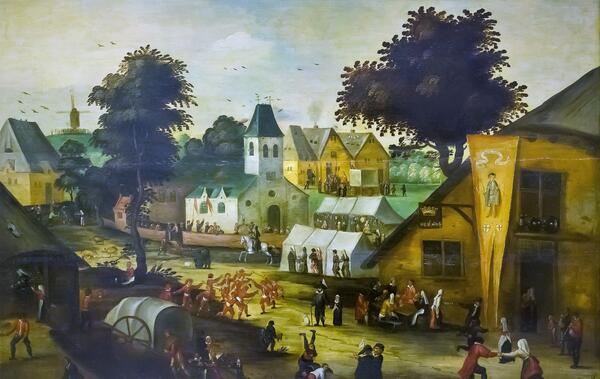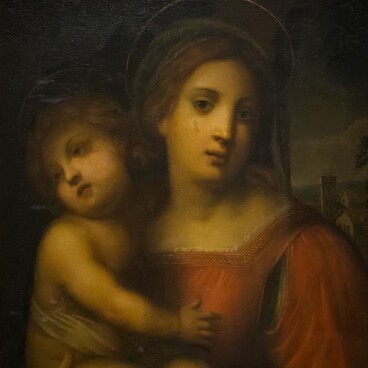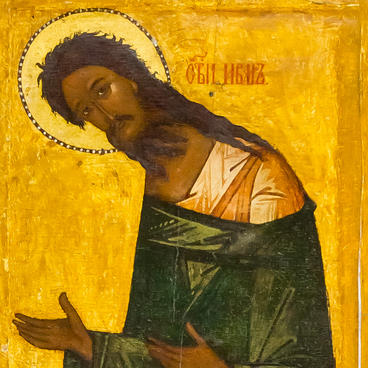‘Village Festivities (Kermesse)’ was painted by a Dutch painter David Vinckboons in the 17th century.
Village festivals were one of the most popular themes in Dutch art of the 16th–17th centuries. Every September, villagers organized festivities to celebrate harvesting. That is why the word ‘kermesse’ — the Old Dutch word for September — was chosen as the name for the festival.
The painting shows a feast in full swing. Movement can be seen in every part of the canvas: musicians play the bagpipes, villagers dance to the music, people talk and drink at the table. On the road, a few men in red clothes perform a sword dance. In the background, a colorful fair is depicted, with a knight in armor prancing near the stalls and a crowd cheering him up with red flags.
While ‘Village Festivities’ shows the true way of life of that time, the artist interspersed the reality with some fictional detail.
David Vinckboons was born in Flanders, the southern region of the Netherlands, but spent most of his life in the north of Holland. Memories of his early years were close to his heart, so in his paintings he used to combine crowded festivals typical of the south with the northern nature. His choice of materials indicates affection for Flanders as well, for it was the Flemish painters who used the oil on wood technique at the turn of the 17th century.
David Vinckboons was a Northern Renaissance artist — he lived and worked at the end of this era. The Renaissance in the Netherlands largely grew out of medieval art, so it was different from Italian art, which drew inspiration from antiquity. While the Italian painters strove for verified proportions and accurate human anatomy, the Dutch ones were famous for realistic textures and detailing: they would make every little crack in objects and every crease on clothes visible in their paintings. Also, they liked the variety and intensity of colors.
David Vinckboons is mostly known for his crowded everyday scenes, landscapes with staffage (small secondary figures that add interest to the composition), and biblical scenes. When closely examined, Vinckboons’s seemingly ingenuous and comprehensible paintings reveal secret symbols and allegories. The artist often raised acute social topics — there is a hidden satire in many of his canvases. Vinckboons’s artwork became a link between the art of Pieter Bruegel the Elder and Adriaen van Ostade — the key Dutch artists of the 16th and 17th centuries.
The painting was donated to the museum from the collection of Andrey Likhachov, a local historian, ethnographer, numismatist, archaeologist, and one of the most prominent collectors in the Volga region.
Village festivals were one of the most popular themes in Dutch art of the 16th–17th centuries. Every September, villagers organized festivities to celebrate harvesting. That is why the word ‘kermesse’ — the Old Dutch word for September — was chosen as the name for the festival.
The painting shows a feast in full swing. Movement can be seen in every part of the canvas: musicians play the bagpipes, villagers dance to the music, people talk and drink at the table. On the road, a few men in red clothes perform a sword dance. In the background, a colorful fair is depicted, with a knight in armor prancing near the stalls and a crowd cheering him up with red flags.
While ‘Village Festivities’ shows the true way of life of that time, the artist interspersed the reality with some fictional detail.
David Vinckboons was born in Flanders, the southern region of the Netherlands, but spent most of his life in the north of Holland. Memories of his early years were close to his heart, so in his paintings he used to combine crowded festivals typical of the south with the northern nature. His choice of materials indicates affection for Flanders as well, for it was the Flemish painters who used the oil on wood technique at the turn of the 17th century.
David Vinckboons was a Northern Renaissance artist — he lived and worked at the end of this era. The Renaissance in the Netherlands largely grew out of medieval art, so it was different from Italian art, which drew inspiration from antiquity. While the Italian painters strove for verified proportions and accurate human anatomy, the Dutch ones were famous for realistic textures and detailing: they would make every little crack in objects and every crease on clothes visible in their paintings. Also, they liked the variety and intensity of colors.
David Vinckboons is mostly known for his crowded everyday scenes, landscapes with staffage (small secondary figures that add interest to the composition), and biblical scenes. When closely examined, Vinckboons’s seemingly ingenuous and comprehensible paintings reveal secret symbols and allegories. The artist often raised acute social topics — there is a hidden satire in many of his canvases. Vinckboons’s artwork became a link between the art of Pieter Bruegel the Elder and Adriaen van Ostade — the key Dutch artists of the 16th and 17th centuries.
The painting was donated to the museum from the collection of Andrey Likhachov, a local historian, ethnographer, numismatist, archaeologist, and one of the most prominent collectors in the Volga region.



